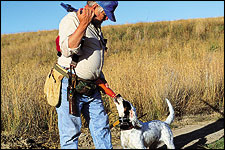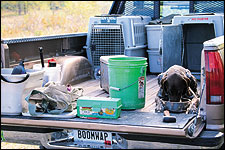Here is what you can do if a serious injury to your dog occurs
By Bob West
 Heat stress during summer training can generally be avoided with a little common sense and plenty of water. |
It is always a good idea to check your dog over at the end of a hunt to check for minor problems. These tailgate inspections should become routine. There are times, however, when a dog needs attention for a major problem as soon as possible. That is the focus of part two of this article.
BROKEN BONES
Broken bones most often involve legs. Usually, the leg hangs unnaturally and the dog cannot put weight on it. The dog should be muzzled immediately and kept as quiet as possible. Movement can cause further damage and enhance the danger of infection. Most veterinarians recommend we do not attempt to place a splint on broken bones. Some support for the injured leg is important, such as a loosely wrapped towel or sweatshirt, while transporting the animal. It helps if a second person can drive while the owner keeps the dog as still and calm as possible. If the skin has been punctured by a badly broken bone, the wound should be kept as clean as possible and bleeding reduced by holding the towel against it without placing painful pressure on it, as you would with a bad cut. Get the dog to the vet immediately.
SEVERE TRAUMA
The highest incidence of trauma among dogs results from being hit by a car. Broken bones and wounds can be minor compared to internal bleeding and shock. Vets say do not pick up the dog by the waist or chest, as you might force a broken rib through a lung or other organ. Put a rug or blanket on the ground and slowly drag the dog onto it by the loose skin of his neck and back. Then you and a hunting buddy can lift the dog to your vehicle by using the blanket as a stretcher.
Once there, quickly check to see that the airway is clear--pull the tongue out and to the side and clear the throat of debris or blood, then cover the dog to maintain body heat and head for the nearest veterinarian.
SHOCK
Shock is lack of adequate blood flow to meet the body's needs. The body tries to correct this loss by accelerating the heartbeat, constricting vessels and conserving fluid in circulation. If allowed to continue, vital organs begin to shut down for lack of oxygen and shock then becomes a self-perpetuating condition, worsening until death occurs.
 Proper field care includes carrying a small plastic box with first-aid supplies and other dog-safety items. |
Shock can be caused by a variety of conditions, including hemorrhage and trauma, infection, heat stress or even dehydration. Some symptoms include a drop in body temperature, lethargy, cold extremities, pale gums and mucus membranes and a rapid but weak pulse. If you suspect your dog may be going into shock, eliminate the cause, if possible, then calm and cover the dog and take him to the vet.
HEAT STRESS
This is one problem we can all learn to identify before it becomes serious. If it does happen, we can move quickly to help the dog. Common sense tells us not to overwork fat or poorly conditioned dogs on a warm day. Not being attentive to fatigue is one cause of heat stress; failure to provide the dog with plenty of cool water is another. Early symptoms are less body and tail action and increased panting. As the problem becomes greater, we'll see aggravated panting, salivation and an expression of panic in the eyes. The gums become dark red and the dog finally has problem with coordination. All are the result of elevated body temperature and that must be your first concern--getting that temperature down. First, flush the mouth with cool water, removing saliva and allowing the dog to drink small amounts. Immerse the animal in cool water if possible, or use wet rags, ice packs or any water available to cool the dog's under parts, tongue and ears. This will cool the blood, which in turn helps cool the entire body. An alcohol bath helps in this cool-down process. Once stabilized, the vet should have a look. Amazingly, the most common cause of heat stress is leaving the dog unattended in a hot vehicle on warm days. This simply should never happen.
| FIRST AID KIT FOR YOUR DOG | 

Your vet or pharmacist should be able to provide you with the following items. Put them in a tackle box or rucksack and take it with you whenever you load up the dog box.
Bedadine ointment
Bedadine scrub
Cotton balls
Cotton swabs
Forceps
Gauze pads
Rectal thermometer
Roll of adhesive tape
Roll of gauze
Saline and dispenser
Scissors
Steroid-free ophthalmic antibiotic ointment
Toenail clippers
|
|
EYE CARE
A dog's eyes attract all sorts of debris because of their close contact with brush and weeds. Weed seeds and other debris can become lodged under eyelids and cause irritation or worse. By carefully spreading the upper and lower lids, you can view the entire eye. Pay attention to the "third" eyelid, a second lower lid, as well as the inside corners--two areas that harbor trapped stuff.
If debris is present, try flushing it free with a stream of saline. If that doesn't work, try blotting it out with a cotton ball soaked in saline solution. CAUTION: do not wipe, only blot softly. Wiping can cause more damage by scratching the eye.
When the eye appears to be clear, ask your vet for a steroid-free antibiotic ophthalmic ointment to be applied two or three times a day. If there is any damage, your vet, as usual, will know how to handle it.
Hopefully, you won't need to use this information, but if you do, you'll be to be prepared to give your hardworking gun dog the emergency care he deserves.






